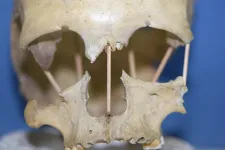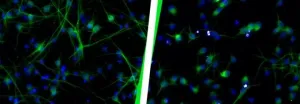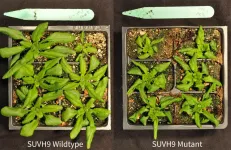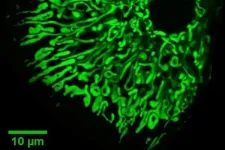Forensic memory detection tests less effective in older adults
New research led by the University of Kent's School of Psychology has found that some brain activity methods used to detect incriminating memories do not work accurately in older adults.
2021-05-20
(Press-News.org) New research led by the University of Kent's School of Psychology has found that some brain activity methods used to detect incriminating memories do not work accurately in older adults.
Findings show that concealed information tests relying on electrical activity of the brain (electroencephalography [EEG]) are ineffective in older adults because of changes to recognition-related brain activity that occurs with aging.
EEG-based forensic memory detection is based on the logic that guilty suspects will hold incriminating knowledge about crimes they have committed, and therefore their brains will elicit a recognition response in the EEG when confronted with reminders of their crimes.
The team of researchers at Kent led by Dr Robin Hellerstedt and Dr Zara Bergström conducted the study with 30 participants under the age of 30 and 30 participants over the age of 65. All participants undertook a concealed information test to detect if they recognised details from a mock crime they had just committed, which would indicate criminal guilt. However, only young adults showed a strong EEG recognition response to reminders of the crime, with such responses being absent in the older group. This failure to detect memories with EEG brain activity occurred even though the older group had the same knowledge about the crime as the younger group, and had just as good general recognition memory ability.
The research published by Cortex therefore suggests that EEG-based forensic memory detection tests have limited practical applications with less validity in older adults than younger populations.
Dr Bergström said: 'Our research demonstrates that EEG-based forensic memory detection in older age is impaired, even with methods that compensate for potential age differences in frequency, timing and location of brain responses.
'Further investigation is needed to examine the ability of these tests to detect concealed memories of real crimes, and whether memory detection in older age is a reflection of permanent changes in brain functioning or is influenced by motivational processes that can vary across situations. Findings could have implications for processes within the criminal justice system, such as the use of polygraph techniques, which may be vulnerable to similar limitations.'
INFORMATION:
Their research paper 'Aging reduces EEG markers of recognition despite intact performance: Implications for forensic memory detection' is published by Cortex. doi: 10.1016/j.cortex.2021.03.015
ELSE PRESS RELEASES FROM THIS DATE:
2021-05-20
For the first time, researchers have successfully sequenced the entire genome from the skull of Peştera Muierii 1, a woman who lived in today's Romania 35,000 years ago. Her high genetic diversity shows that the out of Africa migration was not the great bottleneck in human development but rather this occurred during and after the most recent Ice Age. This is the finding of a new study led by Mattias Jakobsson at Uppsala University and being published in Current Biology.
"She is a bit more like modern-day Europeans than the individuals in Europe 5,000 years earlier, but the difference is much less than we had thought. We can see that she is not a direct ancestor of modern Europeans, but she is a predecessor of the hunter-gathers that lived in Europe until the end of the last ...
2021-05-20
DURHAM, N.C. - A newly identified group of antibodies that binds to a coating of sugars on the outer shell of HIV is effective in neutralizing the virus and points to a novel vaccine approach that could also potentially be used against SARS-CoV-2 and fungal pathogens, researchers at the Duke Human Vaccine Institute report.
In a study appearing online May 20 in the journal Cell, the researchers describe an immune cell found in both monkeys and humans that produces a unique type of anti-glycan antibody. This newly described antibody has the ability to attach ...
2021-05-20
Juvenile salmon migrating to the sea in the Sacramento River face a gauntlet of hazards in an environment drastically modified by humans, especially with respect to historical patterns of stream flow. Many studies have shown that survival rates of juvenile salmon improve as the amount of water flowing downstream increases, but "more is better" is not a useful guideline for agencies managing competing demands for the available water.
Now fisheries scientists have identified key thresholds in the relationship between stream flow and salmon survival that can serve as actionable targets for managing water resources in the Sacramento River. The new analysis, published May 19 in Ecosphere, revealed nonlinear ...
2021-05-20
Today, proteins that can be controlled with light are a widely used tool in research to specifically switch certain functions on and off in living organisms. Channelrhodopsins are often used for the technique known as optogenetics: When exposed to light, these proteins open a pore in the cell membrane through which ions can flow in; this is how nerve cells can be activated. A team from the Centre for Protein Diagnostics (PRODI) at Ruhr-Universität Bochum has now used spectroscopy to discover a universal functional mechanism of channelrhodopsins that determines their efficiency as a channel and thus as an optogenetic tool. The researchers led by Professor Klaus ...
2021-05-20
Microfluidic technologies have seen great advances over the past few decades in addressing applications such as biochemical analysis, pharmaceutical development, and point-of-care diagnostics. Miniaturization of biochemical operations performed on lab-on-a-chip microfluidic platforms benefit from reduced sample, reagent, and waste volumes, as well as increased parallelization and automation. This allows for more cost-effective operations along with higher throughput and sensitivity for faster and more efficient sample analysis and detection.
Optoelectrowetting (OEW) is a digital optofluidic technology that is based on the principles of light-controlled electrowetting and enables ...
2021-05-20
Since our ancestors infected themselves with retroviruses millions of years ago, we have carried elements of these viruses in our genes - known as human endogenous retroviruses, or HERVs for short. These viral elements have lost their ability to replicate and infect during evolution, but are an integral part of our genetic makeup. In fact, humans possess five times more HERVs in non-coding parts than coding genes. So far, strong focus has been devoted to the correlation of HERVs and the onset or progression of diseases. This is why HERV expression has been studied in samples of pathological origin. Although important, these studies ...
2021-05-20
Passing down a healthy genome is a critical part of creating viable offspring. But what happens when you have harmful modifications in your genome that you don't want to pass down? Baby plants have evolved a method to wipe the slate clean and reinstall only the modifications that they need to grow and develop. Cold Spring Harbor Laboratory (CSHL) Professor & HHMI Investigator Rob Martienssen and his collaborators, Jean-Sébastien Parent and Institut de Recherche pour le Développement Université de Montpellier scientist Daniel Grimanelli, discovered one of the genes responsible for reinstalling modifications in a baby plant's genome.
A plant's genomic modifications--called epigenetic ...
2021-05-20
The study sought to describe and explain gender pay differences in the U.S. Department of Health and Human Services between 2010 and 2018. HHS comprises a quarter of the country's governmental public health workers, with over 80,000 employees.
Understanding what may be driving wage gaps at HHS provides opportunities for employers and legislators to take action to support women in the health care field, said lead author Zhuo "Adam" Chen, an associate professor of health policy and management at UGA's College of Public Health.
"A large percentage of the health care workforce are women," said Chen. "If you have underpaid women in the profession, I don't think it spells good things for the public health system."
Chen ...
2021-05-20
Maywood, Ill. - May 19, 2021 - A team of scientists from Loyola University Chicago's Stritch School of Medicine have discovered a critical component for renewing the heart's molecular motor, which breaks down in heart failure.
Approximately 6.2 million Americans have heart failure, an often fatal condition characterized by the heart's inability to pump enough blood and oxygen throughout the body. This discovery could represent a novel approach to repair the heart.
Their findings, published in the May 19 issue of Nature Communications, show how a protein called BAG3 helps replace "worn-out" components of the cardiac sarcomere. The sarcomere is a microscopic ...
2021-05-20
FINDINGS
A new multi-institution study led by a team of researchers at the David Geffen School of Medicine demonstrated that blocking a protein called ABCB10 in liver cells protects against high blood sugar and fatty liver disease in obese mice. Furthermore, ABCB10 activity prompted insulin resistance in human liver cells.
The findings are the first to show that ABCB10 transports biliverdin out of the mitochondria - the cell's "energy generating powerhouses." Biliverdin is the precursor of bilirubin, a substance with antioxidant properties. Consequently, ABCB10 transport ...
LAST 30 PRESS RELEASES:
[Press-News.org] Forensic memory detection tests less effective in older adults
New research led by the University of Kent's School of Psychology has found that some brain activity methods used to detect incriminating memories do not work accurately in older adults.






